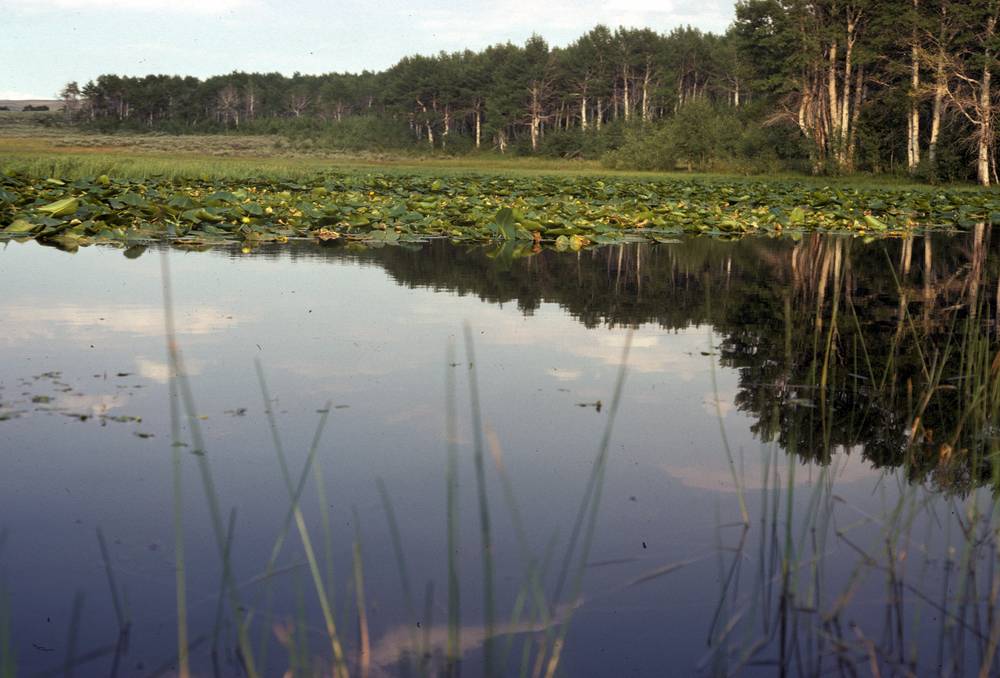
Stems compressed, 10–35 cm; nodal glands absent.
Leaves both submersed and floating or submersed only.
Submersed leaves sessile with blade attached to stipule near middle; stipules persistent to decomposing, ligulate, 15–23 mm, tip obtuse; blades linear, often falcate, 20–40 × 0.5– 1(1.5) mm; base slightly tapering; margins entire; tip acute; lacunae in 1–2 rows on each side of midrib; vein 1.
Floating leaves obovate to elliptic, (10)15–30 × 3–8.5 mm, light green, base acute, tip round to acute, veins 3–7; petioles 7–8 mm.
Inflorescences submersed spikes capitate, 2–3 mm, emersed spikes cylindric, 5–9.7 mm; peduncles axillary, recurved, 3–5 mm, emersed peduncles axillary or terminal, erect to slightly recurved, 6–15 mm.
Fruits sessile, orbicular, compressed, 1–1.5 × 0.9–2 mm, greenish brown, dorsally and laterally winged, lateral wings with sharp points; beaks erect, 0.1 mm.
Ponds, lakes, streams. 1100–1800m. BR, Owy. CA, ID, NV; east to CT, Mexico. Native.
as described under Potamogeton diversifolius
Rhizomes present. Cauline stems compressed, without spots, 10--35 cm; glands absent. Turions absent. Leaves both submersed and floating or floating absent, ± spirally arranged. Submersed leaves sessile, lax; stipules persistent to deliquescent, inconspicuous, convolute, adnate to blade ½ stipule length, light brown to red-brown, ligulate, 1.5--2.3 cm, not fibrous, not shredding at tip, apex obtuse; blade red-brown to light green, linear, often arcuate, 1--1.3 cm ´ 0.1 mm, base slightly tapering, without basal lobes, not clasping, margins entire, not crispate, apex not hoodlike, acute, lacunae present, 1--2 rows each side midrib; veins 1. Floating leaves petiolate; petioles continuous in color to apex, 0.7--0.8 cm; blade adaxially light green, obovate to elliptic, 0.8--1.6 cm ´ 3--8.5 mm, base acute, apex round to acute; veins 3--7. Inflorescences unbranched; peduncles dimorphic, submersed axillary, recurved, clavate, 3--5 mm, emersed axillary or terminal, erect to slightly recurved, clavate, 6--15 mm; spikes dimorphic, submersed capitate, 2--3 mm, emersed cylindric, 5--9.7 mm. Fruits sessile, greenish brown, orbicular, compressed, abaxially winged, laterally winged, 1--1.5 ´ 0.9--2 mm, lateral wings with sharp points; beak present, erect, 0.1 mm; sides without basal tubercles; embryo with more than 1 full spiral.Flowering and fruiting spring--fall. Ponds, lakes, streams, and rivers; 5--2500 m; Ala., Ariz., Ark., Calif., Colo., Conn., Del., Fla., Ga., Idaho, Ill., Ind., Iowa, Kans., Ky., La., Md., Mass., Minn., Miss., Mo., Mont., Nebr., Nev., N.J., N.Y., N.C., N.Dak., Ohio, Okla., Oreg., Pa., S.C., S.Dak., Tenn., Tex., Vt., Va., W.Va., Wis., Wyo. ; Mexico.Potamogeton diversfolius is very likely the most common species of Potamogeton the genus in the southeastern United States. It has been separated into two species, P. diversifolius in the strict sense and P. capillaceus (M. L. Fernald 1932). The species has also been divided into two varieties, var. diversifolius and var. trichophyllous Morong (D. O S. Correll and M. C. Johnston 1970) . Potamogeton diversifolius var. trichophyllous actually is misapplied, as the name really refers to the more northern P. bicupulatus Fernald. We are following E. J. Klekowski Jr. and E. O. Beal (1965) in accepting only one taxon, as we have studied the species over much of its range and reached similar conclusions.